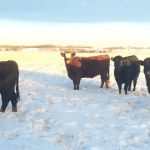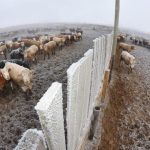Reading Time: 2 minutes Western Canadian feeder cattle prices for 800-pound plus cattle were $2/cwt to $4/cwt higher on average for the week ending January 27. Feeders in the 500-800-pound category were up $3/cwt to $6/cwt with higher quality groups up as much as $10/cwt in some cases. Feeders 500 pounds and lower were unchanged from seven days earlier.

Klassen: Positive fed outlook buoys feeder market
Market telling producers to own lighter cattle sooner rather than later

Feed grain weekly outlook: Buyers looking towards springtime
Analysts suggest farmers will grow less barley
Reading Time: 2 minutes Feedlots continued to purchase corn imports from the United States, putting pressure on feed barley and wheat prices in Western Canada. However, the prospective of fewer planted acres this spring could give prices a boost.

Alberta expands livestock drought recovery supports
Only a narrow band of the province remains exempt from the aid program
Reading Time: 2 minutes The 2023 Canada-Alberta Drought Livestock Assistance initiative, funded through the AgriRecovery framework by the federal and provincial governments, offers payments of up to $150 per head to livestock producers who have 15 or more animals per type of livestock, and have altered usual grazing practices for more than 21 days due to drought.

Klassen: Feeder market holds value despite negative margins
U.S. demand limited with colder temperatures in Midwest
Reading Time: 2 minutes Calf markets appeared to trade $2 to $3 above week-ago levels on average. Feedlot margins on current pen close-outs are negative $300 to $350 per head but replacement markets haven’t missed a beat. Finishing feedlots were once again bidding aggressively on backgrounded cattle with fleshier types experiencing limited slippage. Larger pen sized groups were on the higher end of the priced spectrum with buyers avoiding smaller packages.

China to encourage hog farmers to reduce capacity after price slump
Aggressive expansion in Chinese hog sector turns to mounting losses on demand downturn
Reading Time: 2 minutes China will "guide" farmers to reduce hog production capacity as it steps up regulation of the industry, the agriculture ministry said on Tuesday, after an aggressive expansion drive led to an oversupply of pigs and heavy losses.

Beef marks GHG drop: report
Assessment reveals industry has reduced emissions by 15 per cent
Reading Time: 2 minutes Producing a kilogram of boneless beef cuts today involves 15 per cent fewer greenhouse gas emissions than in 2014, according to the recently released National Beef Sustainability Assessment (NBSA) and Strategy report.

Ag minister talks Proposition 12, VCOOL with the U.S.’s Vilsack
The trip marks MacAulay's first ministerial visit to the U.S. since regaining the role
Reading Time: 2 minutes Proposition 12 and voluntary country of origin labelling (VCOOL) were among topics raised during federal Ag Minister Lawrence MacAulay's first ministerial trip to to the U.S. after being appointed to the portfolio late last year.

Philippines bans poultry imports from California, Ohio to prevent bird flu spread
The country recently halted imports from Belgium, France on disease concerns
Reading Time: < 1 minute The Philippines' farm ministry said on Wednesday it has banned poultry imports from California and Ohio in the United States because of several outbreaks there of highly pathogenic avian influenza.

Klassen: Yearling return to the lineup on strong demand
Frigid temperatures result in limited volumes
Reading Time: 2 minutes The market hasn’t missed a beat and started the year where it left in December. The only difference is there are larger supplies of yearlings coming on stream. The benchmark levels had backgrounded steers averaging 1,000 pounds trading from $280-$285/cwt with top bids rounding at $290/cwt. Steers averaging 850-pounds were averaging $300/cwt with top-notch larger groups peaking at $305.

Feed grain weekly outlook: More U.S. corn deliveries to feedlots
Frigid temperatures unlikely to disrupt grain deliveries, analyst says
Reading Time: 2 minutes The New Year still hasn’t whetted the appetite for corn from the United States to Alberta feedlots.


 Livestock
Livestock